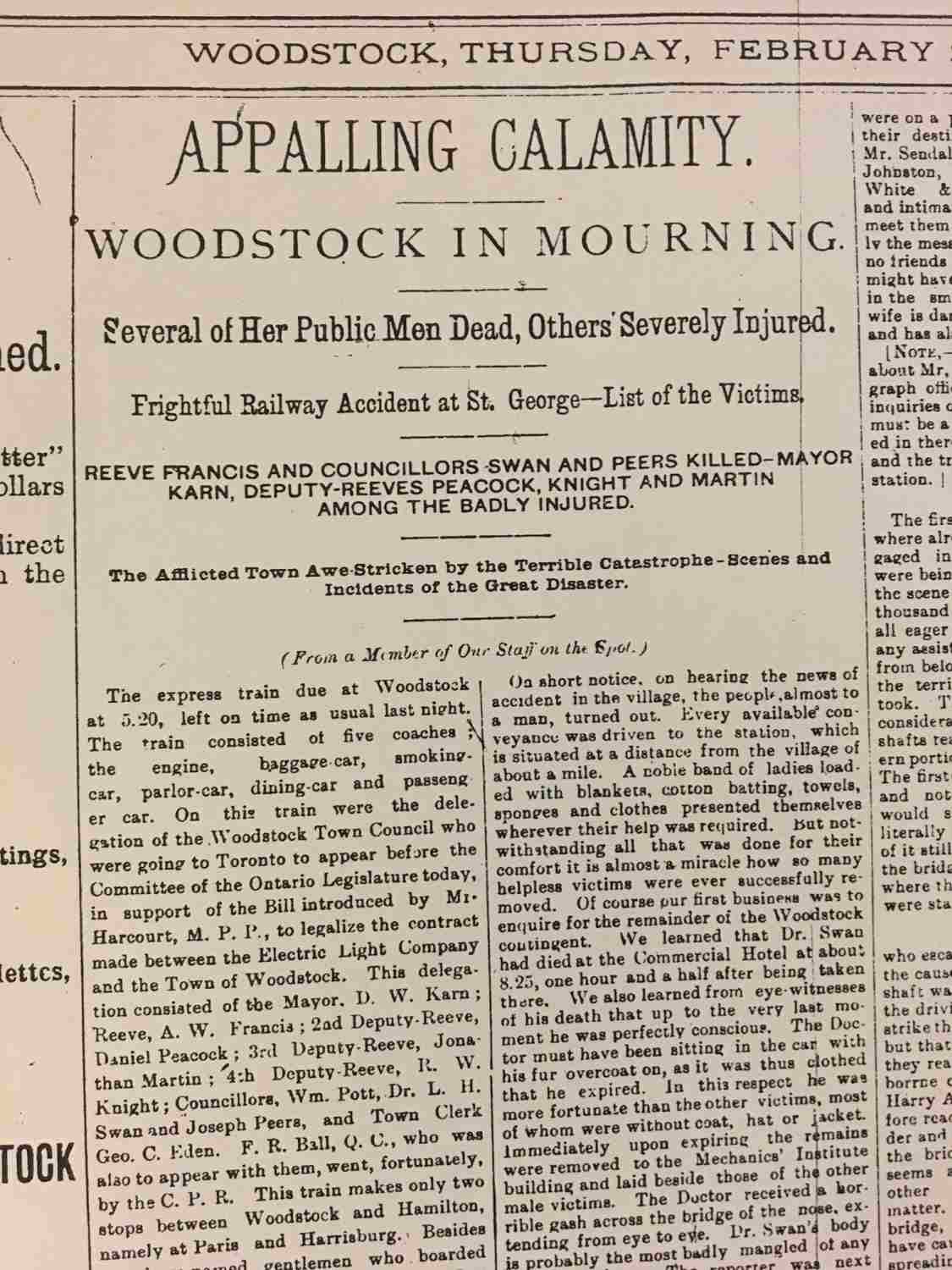St. George Train Disaster
St. George Train Disaster
A history of the St. George train disaster, which led to the death of four Woodstock Council members in 1889.
By Liz Dommasch, County Archivist
This past weekend marks the anniversary of the St. George Train Disaster. On that ill-fated day, February 27, 1889 a delegation of Woodstock Councillors boarded the St. Louis express train to Toronto in order to attend the hearing of the Electric Light Bill before the Ontario Legislature. As Woodstock was a leading figure in the changeover from gas to electric lights, it was important that they be present. Although all of the Town’s Council were invited to attend, the delegation ended up consisting of Mayor D.W. Karn; Reeve A.W. Francis, Deputies Daniel Peacock, Jonathan Martin and R.W. Knight; Councillors Dr. L.H. Swan, William Potts and Joseph Peers, as well as Clerk George C. Eden.
The trip was uneventful until the train approached the bridge over the Grand River, near the Village of St. George, when one of the drivers on a forward wheel broke loose and began tearing up the rail ties. The engine, baggage car and smoker (that contained Eden and Potts) manage to clear the trestle before the tracks gave away. Unfortunately, the next two passenger coaches derailed and plunged into the gorge, while the final dining car hung precariously from the trestle above.
According to the news reports of the time, the scene after the disaster was appalling with some being spilled from the derailed cars to the canyon below, while others were buried in debris. The Mayor and Councillors Knight and Swan were found injured, but alive, in one corner of the car and were pulled from the wreckage by Councillor  Potts and Clerk Eden. Sadly, Dr. Swan would die from his injuries shortly afterwards at the hotel in St. George, which had been turned into an emergency hospital to care for the injured. The body of Reeve Francis, editor of the local newspaper “The Standard”, was found lying on the ground outside the train and Councillor Peers, a brickyard owner and son of one of the town’s founders, was killed instantly. Councillor Jonathan Martin would succumb to his injuries over a month later, bringing the final death toll of the disaster to eleven.
Potts and Clerk Eden. Sadly, Dr. Swan would die from his injuries shortly afterwards at the hotel in St. George, which had been turned into an emergency hospital to care for the injured. The body of Reeve Francis, editor of the local newspaper “The Standard”, was found lying on the ground outside the train and Councillor Peers, a brickyard owner and son of one of the town’s founders, was killed instantly. Councillor Jonathan Martin would succumb to his injuries over a month later, bringing the final death toll of the disaster to eleven.
News of the accident would reach Woodstock shortly after 7 p.m. and family members, doctors and clergy would quickly board a relief train from London to take them to St. George. The Councillors that had remained at home called an emergency meeting and in conjunction with the towns’ ministers declared March 2, 1889 as a day of mourning. On that day, businesses closed and flags were flown at half-mast. It is said that an estimated 20,000 to 25,000 people crowded into the town to bear witness to Woodstock’s grief. Separate funeral services were held at Old and New St. Paul’s Churches and the Methodist Church and a combined funeral procession was formed at the conclusion of each service that was a mile and a half long and took over an hour to pass the market square. The procession ended at the two main cemeteries where Dr. Swan, Reeve Francis and Mr. Peers were given full military and Masonic honours. Following the day of mourning the city observed a further period of bereavement by cancelling all public festivities.
Although the Woodstock delegation did not make it to Toronto that fateful day, the Electric Light Bill would be passed by the Legislature and the town of Woodstock would be one of the first to sign it.
